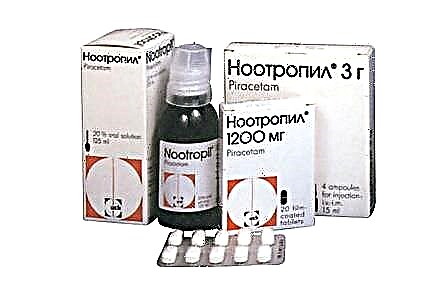Nasal mucus is the most common reason for parents to consult with their pediatricians. However, it is not always possible to accurately understand the reason for the child's discomfort, since this is permissible only by indirect signs, because the baby is not yet able to talk. Therefore, you need to know how to determine a runny nose in a baby and how to help a baby, depending on the reasons that caused it.

Runny nose in a baby
Causes of the common cold
Discharge of the nasal mucosa occurs due to the fact that the human body has barriers that protect it from the external environment. The mucous membranes cover from the inside those organs through which infections and other irritants can enter the body.
Important! The production of mucus is activated when the body needs protection.
The causes of nasal congestion are varied:
- Features of the physiology of the baby. In children in the first months of life, mucus secretion is active, which is necessary for the successful adaptation of babies to external conditions. No treatment for a physiological rhinitis is required;
- Upper respiratory tract infections such as colds or flu;
- Sudden temperature changes. For example, a child was taken out for a walk in the cold air. On returning to a warm room, the nasal congestion should soon disappear;
- The environment is too dry. When the heating is on in the house, the air is usually dry. If adults do not react so sharply to this, then babies may have mucus in the nose;
- Inhalation of irritants. This is the so-called allergic rhinitis;
- The presence of a foreign object in the nose.
- In some babies, nasal mucus is one of the symptoms of teething;
- Environmental pollution. An infant may have snot from dust in the air, tobacco smoke, or sprayed deodorants.
Types of rhinitis and symptoms
Different types of nasal congestion have different accompanying symptoms. The question for parents is not only how to understand that a newborn has a runny nose, but also how to be able to determine its nature.
Physiological rhinitis
Physiological nasal congestion is natural for a newborn. It is associated with his adaptation to breathing through the nose. Intrauterine oxygen entered the fetus with maternal blood, and the respiratory process was absent. Immediately after birth, the mucosal glands do not work because the fetus did not need to moisturize the nasal cavity.
When the infant begins to breathe, it becomes necessary to moisturize, cleanse and heat the air entering the lungs. At this point, the glands of the nasopharynx begin to produce excess mucus, since their functioning is still poorly regulated. Sometimes mucus can go down the back of the throat. Then a physiological rhinitis is accompanied by a cough. With the normalization of the work of the glands of the nasopharynx, the manifestations of physiological rhinitis decrease and disappear.
Important! If you regularly take measures to remove nasal discharge with medication and rinsing, the mucous membrane will dry out, the glands will produce more mucus, increasing the duration of the runny nose.
Signs by which you can recognize a physiological rhinitis:
- the general condition of the baby does not inspire concern;
- the baby has a good appetite and restful sleep;

Baby has a restful sleep
- lack of elevated temperature;
- there is no edema of the mucous membrane, breathing is free;
- the mucus is liquid and transparent, its amount is insignificant;
- when the baby is breastfeeding, he can sniff and press the nose to the breast.
When physiological rhinitis is associated with the appearance of the first teeth, it is due to increased blood flow in the upper jaw and nasal cavity. The inflammation can spread to the nasopharynx, so a runny nose appears. It can be recognized by other characteristic symptoms: swelling of the gums, salivation, fever.
Allergic rhinitis
It is a periodic or chronic inflammation of the nasal mucosa caused by an allergic reaction to various stimuli: pollen from flowering plants, hair of animals living at home, dust mites, chemicals, etc.
How to understand that a baby has snot provoked by an allergy? To do this, you need to carefully observe him, noting the presence of the following symptoms:
- persistent liquid nasal discharge, which does not change its consistency, but is very abundant;
- secreted nasal mucus can sink to the back of the throat and cause a cough;
- the child sleeps with his mouth open, since swelling of the mucous membrane makes it difficult for air to enter;
- the eyes turn red and tears flow from them.
Important! A typical dust mite allergy is repeated sneezing after your baby wakes up.

Baby sneezes
Viral rhinitis
Despite parents' best efforts to protect their children, they can catch colds and get sick. In the cold season, viruses attack adults and babies, they are easily transmitted through the air, if someone in the family gets sick, the baby can catch the infection. His immune system is still developing, which makes the child vulnerable to colds.
Given that in the first months of life, a newborn should not take medications (except in cases of serious illnesses that require special therapy), even fighting a simple cold can be difficult for the baby and his parents.
To find out that a child has a viral rhinitis, you need to pay attention to the following symptoms:
- the baby becomes nervous and restless;

The baby becomes irritable
- nasal congestion appears due to secreted mucus, which is at first transparent and liquid, then thickens and becomes whitish, and after a few days it will be liquid and clean again;
- in the early days, the temperature may rise, although not high;
- the baby does not suck well on the breast or bottle, as it is difficult for him to breathe;
- coughing, sneezing may appear;
- Red eyes.
Bacterial rhinitis
It is not often found in infants, but this is the most dangerous type of rhinitis that can provoke serious complications.
To understand that a child has a bacterial rhinitis follows the symptoms:
- thick mucus, yellowish-green in color;
- the temperature rises significantly 38 ° C and more;
- the baby does not sneeze or cough;
- irritability, poor sleep and appetite.
Important! In the case of a bacterial rhinitis, a doctor's consultation is imperative, who can make the correct diagnosis based on laboratory analysis.
Length of runny nose and the possibility of walking
The duration of a physiological rhinitis is usually up to 10 weeks. In a three-month-old baby, all its manifestations should already be gone. In favorable external conditions (air humidity - 60%, temperature - up to + 20 ° C), a runny nose will pass faster. If the air is too dry and the room is very hot, rhinitis may last longer.
Important! Walking with a baby with physiological rhinitis is not only not prohibited by doctors, but even recommended. Fresh air has a beneficial effect on the nasal mucosa.

Walking with a baby
Allergic rhinitis continues until irritation is eliminated. Viral rhinitis lasts a little over a week on average. At the same time, walks should not be stopped if the general condition of the baby is satisfactory (no temperature, etc.), as well as if the weather conditions are favorable (there is no strong wind, rain, frost). Staying in the fresh air helps the baby fight coryza.
When you need to call a doctor
A doctor's call is necessary mainly in the case of a viral or bacterial nature of the common cold. However, ARVI is not always a condition that can cause serious consequences.

Calling a doctor for a child
You should see a doctor immediately when:
- The child is less than 3 months old, his temperature is 37.5 ° C and above. While this should not be intimidating, even small increases in temperature in the first months of life should not be underestimated;
- SARS symptoms do not disappear after a week;
- The cough gets worse and breathing problems appear (wheezing, etc.);
- The lips become bluish. This is a sign that the baby is not breathing well and is not absorbing enough oxygen;
- The mucus shows minimal traces of blood;
- There is severe redness or swelling of the pharynx;
- Vomiting occurs in addition to respiratory symptoms;
- The child is constantly reaching for the ears. This can be the penetration of the infection into the ear area.
Complications and preventive measures
Complications with rhinitis:
- chronic inflammation of the paranasal sinuses (sinusitis, sinusitis);
- the formation of polyps in the nose;
- the appearance of bronchial asthma;
- inflammation of the bronchi (bronchitis);
- ear inflammation (otitis media).
In addition, shortness of breath does not provide a sufficient flow of oxygen to the baby's body, which affects its development.
In addition to correctly determining the type of cold in an infant, it is important to know about preventive measures:
- Frequent airing of the room (up to several times daily);

Airing the room
- Creation of sufficient air humidity. For this, humidifiers or water reservoirs simply installed next to the bed are suitable;
- The air temperature in the nursery should not exceed 20 ° C;
- Timely wet cleaning;
- In case of allergic rhinitis - immediate removal of all irritants: animals, indoor plants, smoking in the house and the presence of chemicals in the air must be excluded;
- Daily walks, preferably in a forested area;
- Breastfeeding should be preferred whenever possible;
- It is necessary to postpone vaccinations if the baby has a runny nose;
- Compliance by all family members with the rules of personal hygiene (washing hands, wearing gauze bandages in case of illness, etc.);
- Periodic rinsing of the nose with saline or "Aquamarine" is possible. But you shouldn't do it too often.
Learning to understand the causes of the common cold and take the necessary measures to alleviate the baby's condition will not present a difficult task for parents. However, in case of any doubt, a visit to the doctor is necessary.



